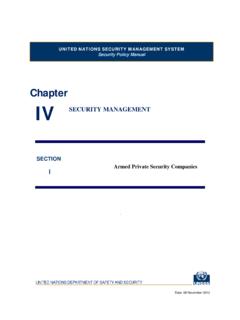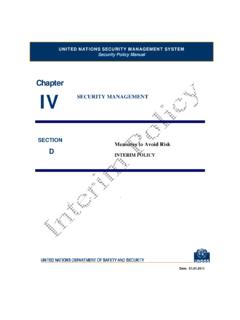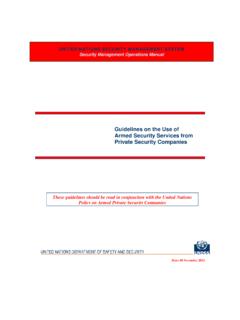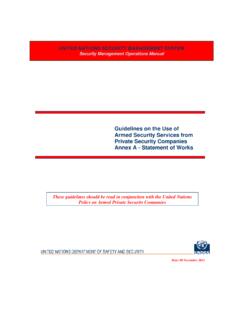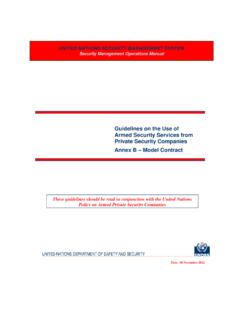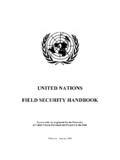Transcription of SPM VIII D Road Safety - World Health Organization
1 PROVISIONS ON Safety MATTERS road Safety . Date: 31 October 2011 UNITED NATIONS security MANAGEMENT SYSTEM security policy manual Chapter VIII SECTION D unsms security policy manual Chapter VIII: PROVISIONS ON Safety MATTER D. road Safety - 1 A. Introduction 1. road and vehicle-related accidents are a common cause of injury and death among United Nations personnel. Poor road Safety practices are not only a danger to drivers, passengers and other road users, they impede the ability of the organisation to implement its programmes. Further, unsafe driving practices and road traffic accidents involving United Nations vehicles can generate resentment within the local population towards the United Nations, potentially creating further security incidents. B. Purpose 2. The purpose of this policy is to promote the safe operation of United Nations vehicles1 World -wide, to ensure road Safety and to describe the roles and responsibilities of relevant United Nations security Management System actors in improving awareness and compliance with requirements and provisions for road Safety .
2 C. Applicability 3. The policy is applicable to all individuals covered by the United Nations security Management System, as defined in Chapter III of the security policy manual ( Applicability of the United Nations security Management System ) and to all non-UN personnel who are passengers in United Nations vehicles. For the purpose of this policy , the term driver applies to any person who operates a United Nations vehicle. D. Conceptual Framework 4. Global road Safety has been a subject of attention by staff, managers and even Member States who have repeatedly registered their concern at the burden of injury and death resulting from road traffic accidents. United Nations personnel have an obligation to promote road Safety by their own behaviour as drivers and road users. The policy sets out safe practices for operating and driving United Nations vehicles.
3 5. The strategy of the United Nations for managing the risk from road Safety hazards is one of both prevention and mitigation, as discussed in the security policy manual , Chapter IV, policy and Conceptual Overview of the security Risk Management Process , paragraph 5. Prevention entails measures intended to lower the likelihood of a road traffic accident occurring, such as driver training, driver regulations and Safety -awareness programs. Mitigation entails measures intended to lower the impact of a road traffic accident once it has occurred, 1 For the purpose of this policy , United Nations vehicle means a wheeled, ground transport motor vehicle (either owned, leased or rented) operated by any member Organization of the United Nations security Management System ( unsms ). unsms security policy manual Chapter VIII: PROVISIONS ON Safety MATTER D.
4 road Safety - 2 including the use of seatbelts and plans and preparations for medical attention, including first-aid training drivers and other personnel. 6. Because of the large number of United Nations vehicles engaged in numerous road missions daily, there is a need for a global policy that sets out detailed requirements for the management of risks from road Safety hazards. 7. The current policy shall be read in conjunction with the latest polices on the use of United Nations road transport and materials produced for any on-going road - Safety campaigns, including that of the Department of Safety and security . E. Requirements for United Nations System Organizations 8. United Nations system organizations are responsible for ensuring compliance with the provisions of this policy for each location where they manage vehicles. Each United Nations system Organization has a responsibility for ensuring the Safety of its personnel and property and should disseminate policies and take other appropriate measures accordingly.
5 Nothing in the provisions of this policy restricts United Nations organizations from implementing stricter measures for road Safety or determines the non- Safety -related vehicle policies that United Nations organizations have in place for driving authorization, use of vehicles, etc. 9. United Nations system organizations are responsible for initiating, in all locations where they manage vehicles, road Safety information and awareness campaigns for their personnel, including the rules and regulations for road Safety , United Nations statistics (and, where available, national statistics) on road traffic accidents, and for providing, in consultation and coordination with United Nations Department of Safety and security , safe-driving training for drivers that reinforces the notions of Safety first and defensive driving . 10. United Nations organizations shall ensure that vehicles are properly managed and maintained in a road worthy condition, including according to local legislation.
6 11. United Nations organizations shall ensure the widest distribution of this policy to all personnel and the basic provision thereof in every United Nations vehicle. 12. In addition to the provisions of Section J below, United Nations system organizations are strongly encouraged to implement programs to reward drivers who demonstrate a safe driving record. 13. Designated Officials are responsible for implementing first-aid and medical response plans and preparations (including for adequate training and equipment) for their area of responsibility so that United Nations personnel injured in a road traffic accident can receive adequate medical response as soon as possible (in accordance with applicable medical guidelines). Casualty Evacuation and Medical evacuation plans are also required and shall be included, along with other road Safety requirements, as part of the country security plan, as per Chapter IV, Sections M and R of the security policy manual .
7 unsms security policy manual Chapter VIII: PROVISIONS ON Safety MATTER D. road Safety - 3 F. Requirements for United Nations Vehicles 14. United Nations vehicles shall be in compliance with the United Nations Minimum Operating security Standards (UN MOSS) set out in the security policy manual , Chapter IV, Section N, Appendix 1, paragraphs 15. In addition to the MOSS requirements, all United Nations vehicles must be equipped with properly functioning, standard Safety features, including, but not limited to, seat belts for all driver and passenger seats, headlights, brake lights, signal lights, tires (including spares), special signaling for breakdowns (reflective vests, flares, etc.), and primary and emergency brakes. 16. United Nations system organizations should also consider the procurement of official vehicles with tested and proven Safety features including, but not limited to, Daytime Running Lights (DRL) , Anti-Lock Braking Systems (ABS) , airbags, and systems to alert maximum safe speeds.
8 17. United Nations vehicles shall be used for official purposes only, unless otherwise authorised. G. Requirements for Drivers 18. In order to lower the risk from road Safety hazards, all persons operating a United Nations vehicle shall: a. Check, before departure and upon return, that the vehicle is in a roadworthy condition, has not been tampered with and that it contains all necessary functioning equipment required by Minimum Operating security Standards and other requirements as per Section F above. b. Immediately report all defects in the vehicle and/or its Safety -related equipment to the United Nations official responsible for vehicle and transport management in their respective Organization . c. Use all Safety -related equipment, including that outlined in Section F above, in the proper and prescribed manner. d. Be duly authorised by their respective United Nations system Organization to operate the vehicle at the duty station, posses a valid driving license recognized by the United Nations and/or the host country, possess all required certification not covered by standard driving licences ( for heavy or special use vehicles), and pass any required practical and written driving and road Safety tests.
9 2 Any Safety issues related specifically to armoured vehicles will be dealt with in separate documents on armoured vehicles standards. unsms security policy manual Chapter VIII: PROVISIONS ON Safety MATTER D. road Safety - 4 e. Be competent to operate the vehicle safely in all local conditions (including snow, ice, and sandstorms), to invoke defensive driving techniques as necessary, and to use radio/communications equipment properly. f. Be medically cleared for driving by the UN and/or local authorities, including an approved eyesight test at least biennially and be equipped with the prescribed methods for correcting vision (eye glasses, contact lenses, etc.). g. Drive with due care at all times, maintaining the highest level of consideration towards passengers, other road users and pedestrians, including by obeying all national codes, driving regulations and speed limits.
10 H. Adjust the speed of the vehicle according to local driving conditions ( low visibility, rain, snow, etc.) to ensure a safe speed at all times and a safe distance from other vehicles on the road . i. Wear their seatbelt and advise passengers to also wear seat-belts. j. Not operate the vehicle, in any situation or in any circumstance, under the influence of any substance that may impair their ability to operate the vehicle, including, but not limited to, alcohol, drugs, narcotics, psychotropics, chemical substances and medicines. k. Not operate the vehicle knowing that his/her ability to do so safely has been impaired, affected, or influenced by illness, fatigue, or injury. l. Abstain from activities that would interfere with, or distract from, their exercising full control over the vehicle, including, but not limited to, consuming food/beverages, or smoking while the vehicle is in motion.










